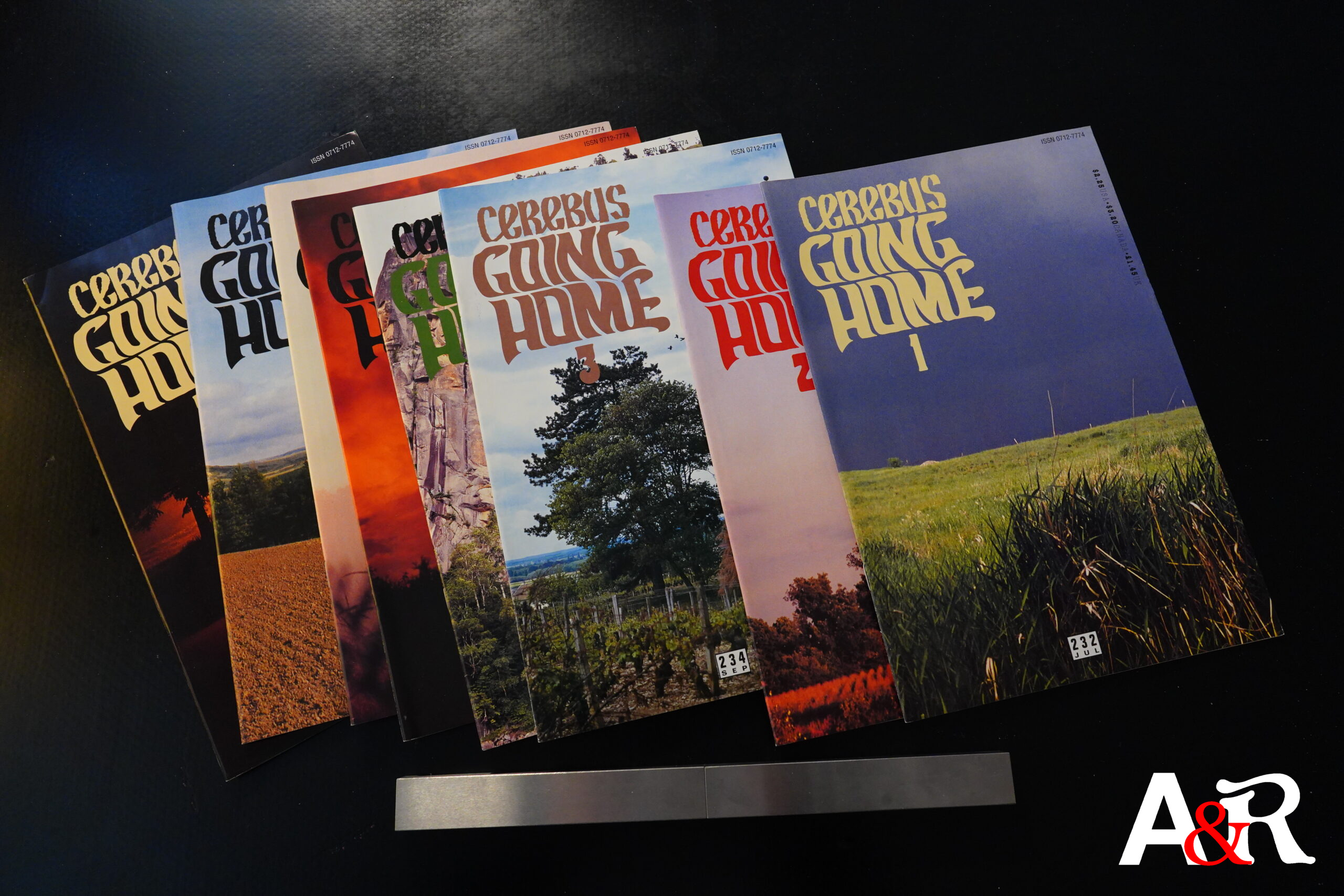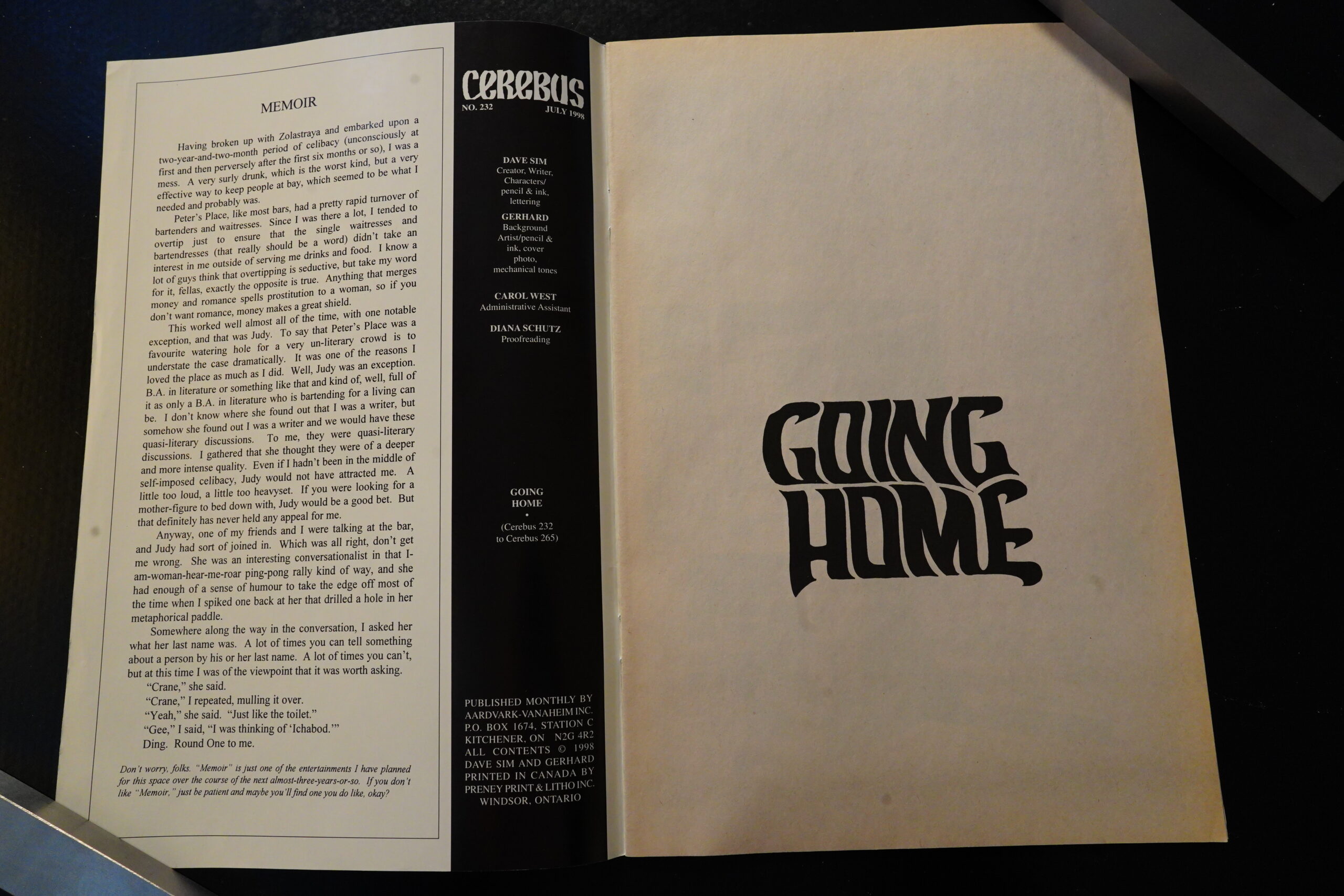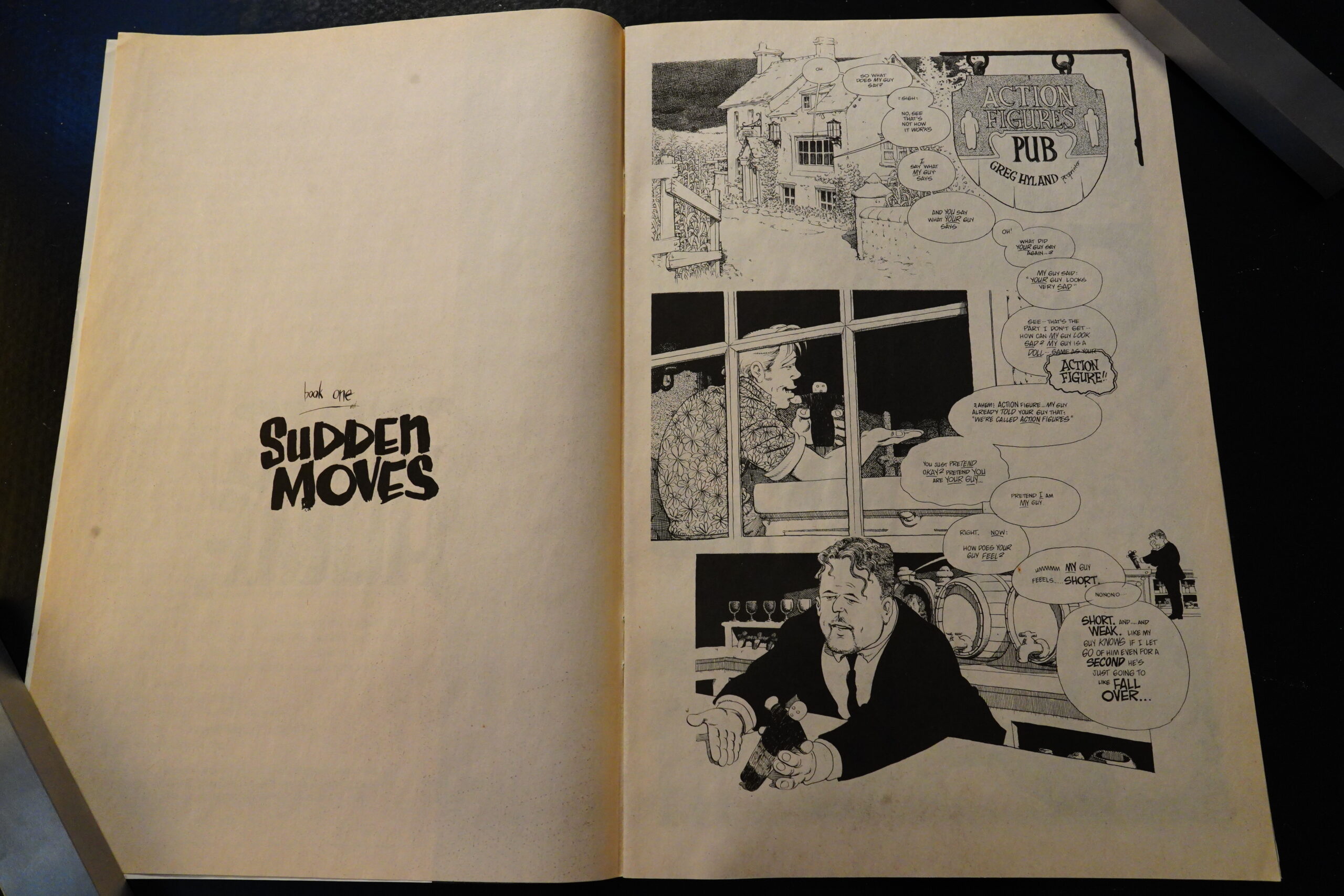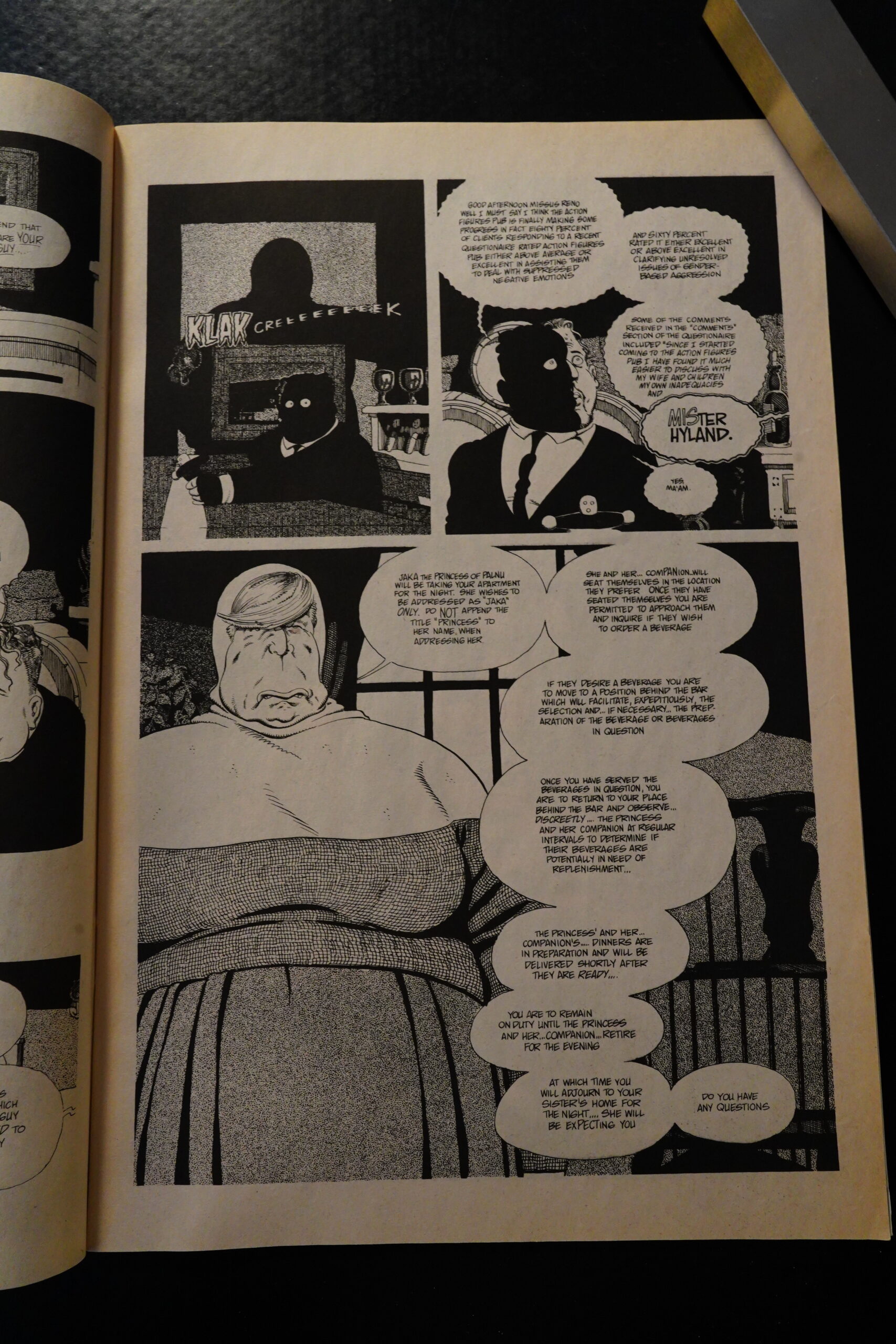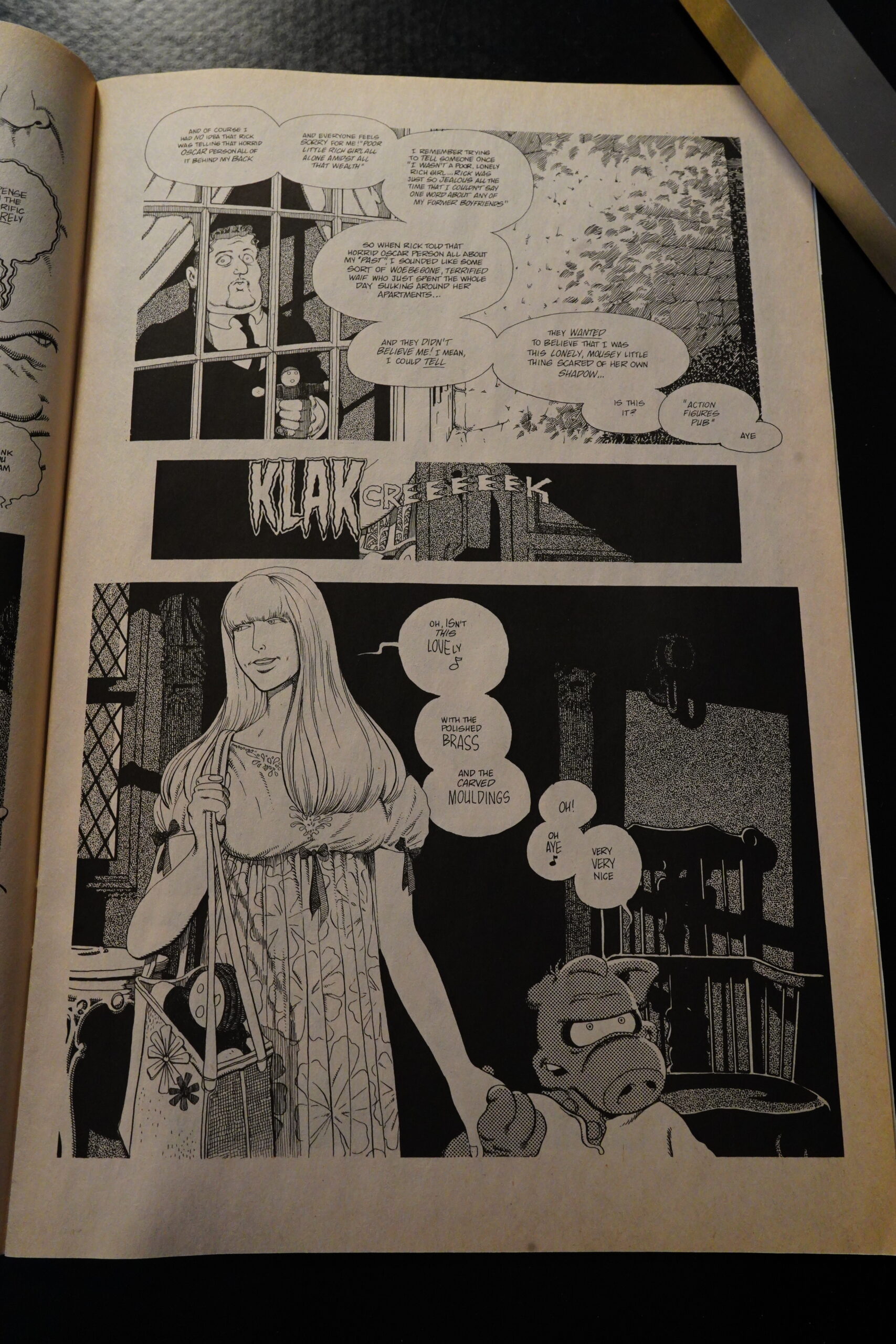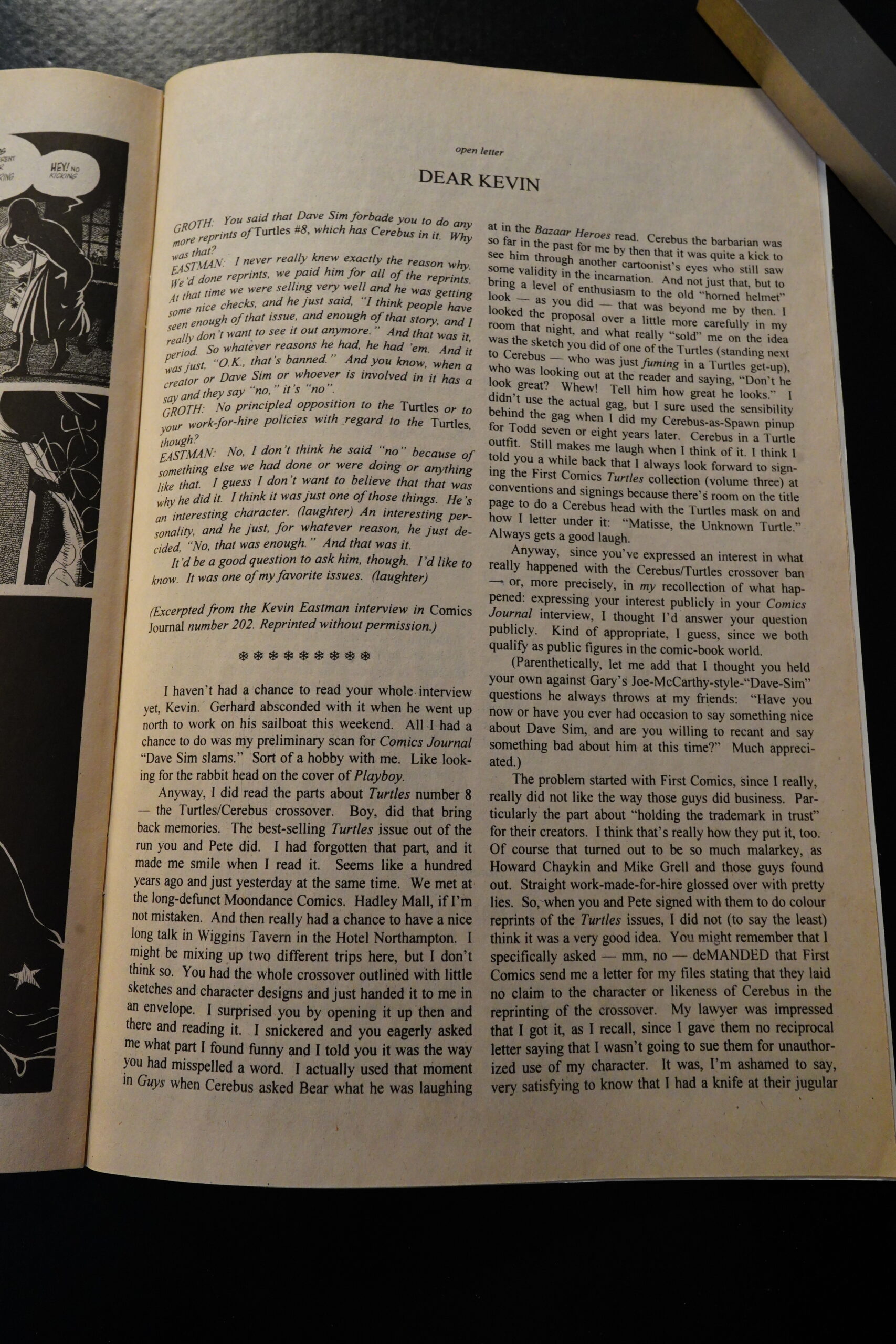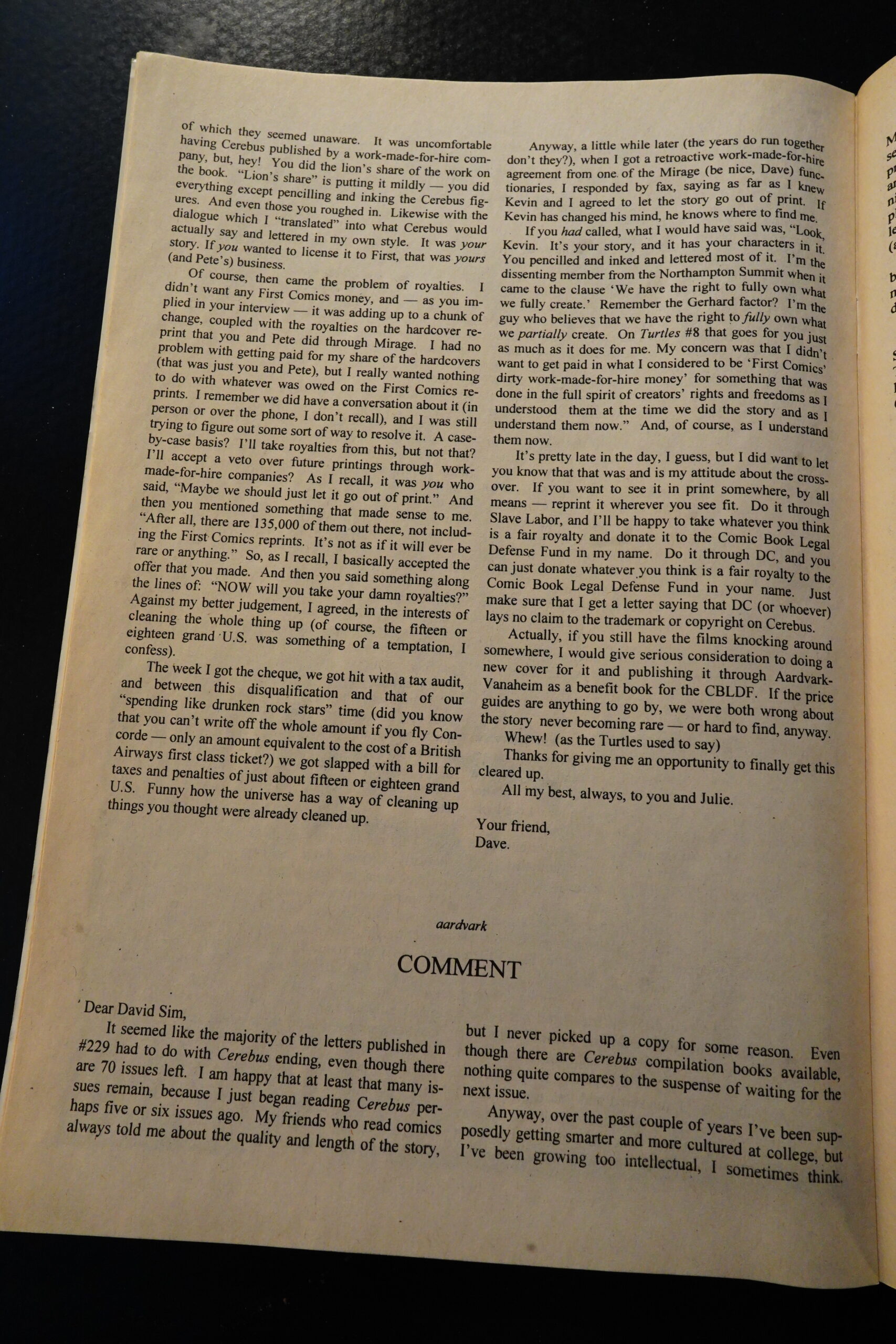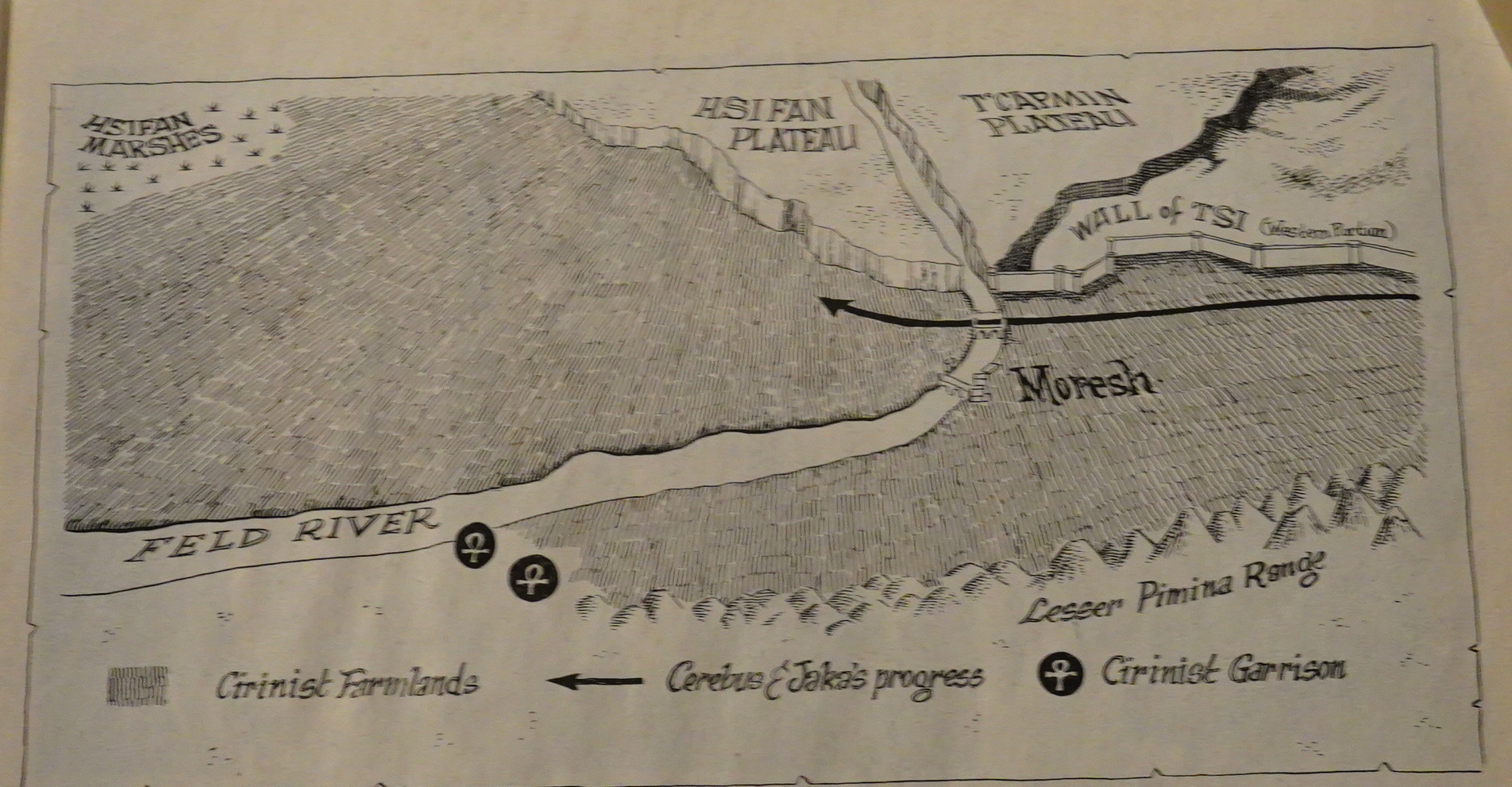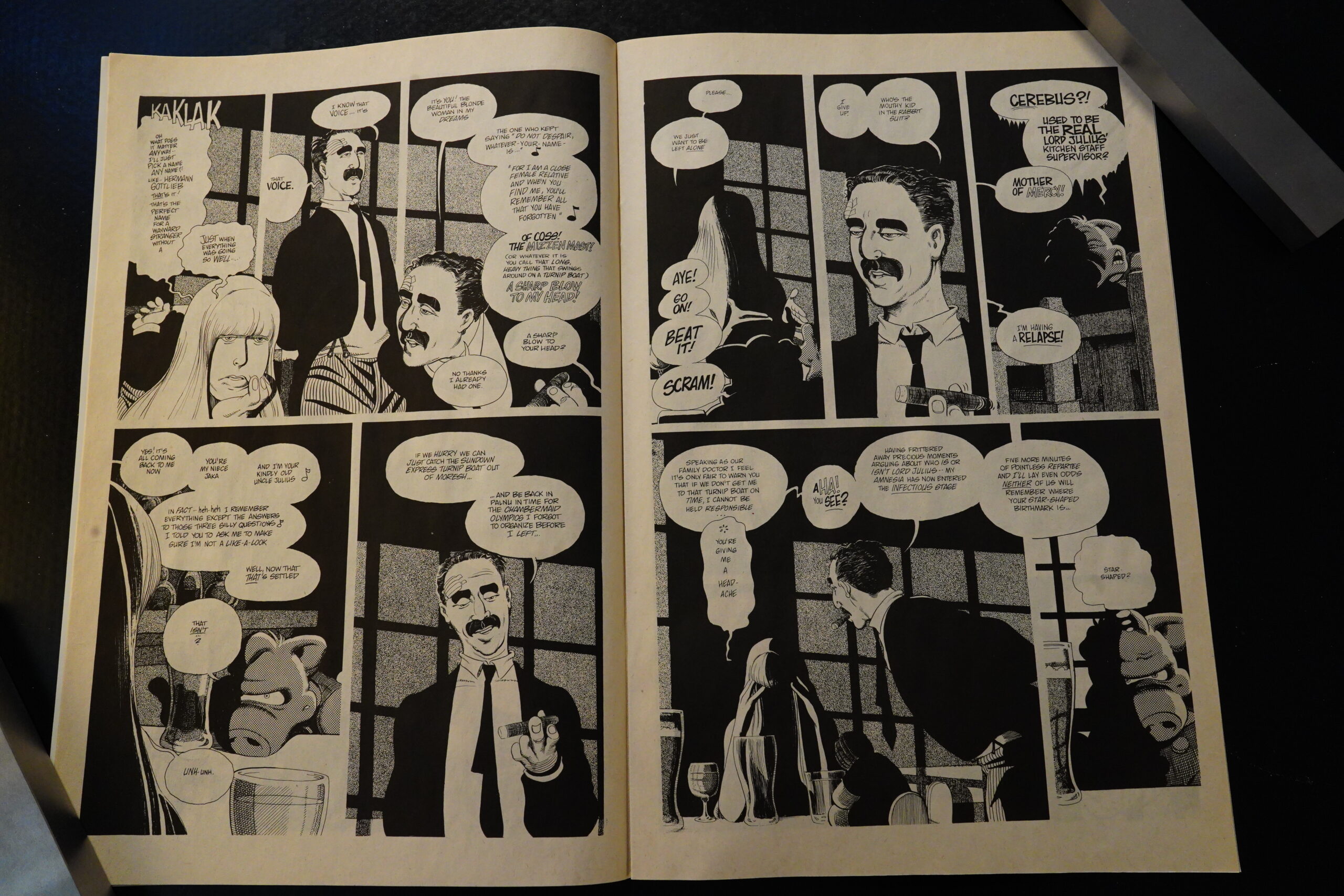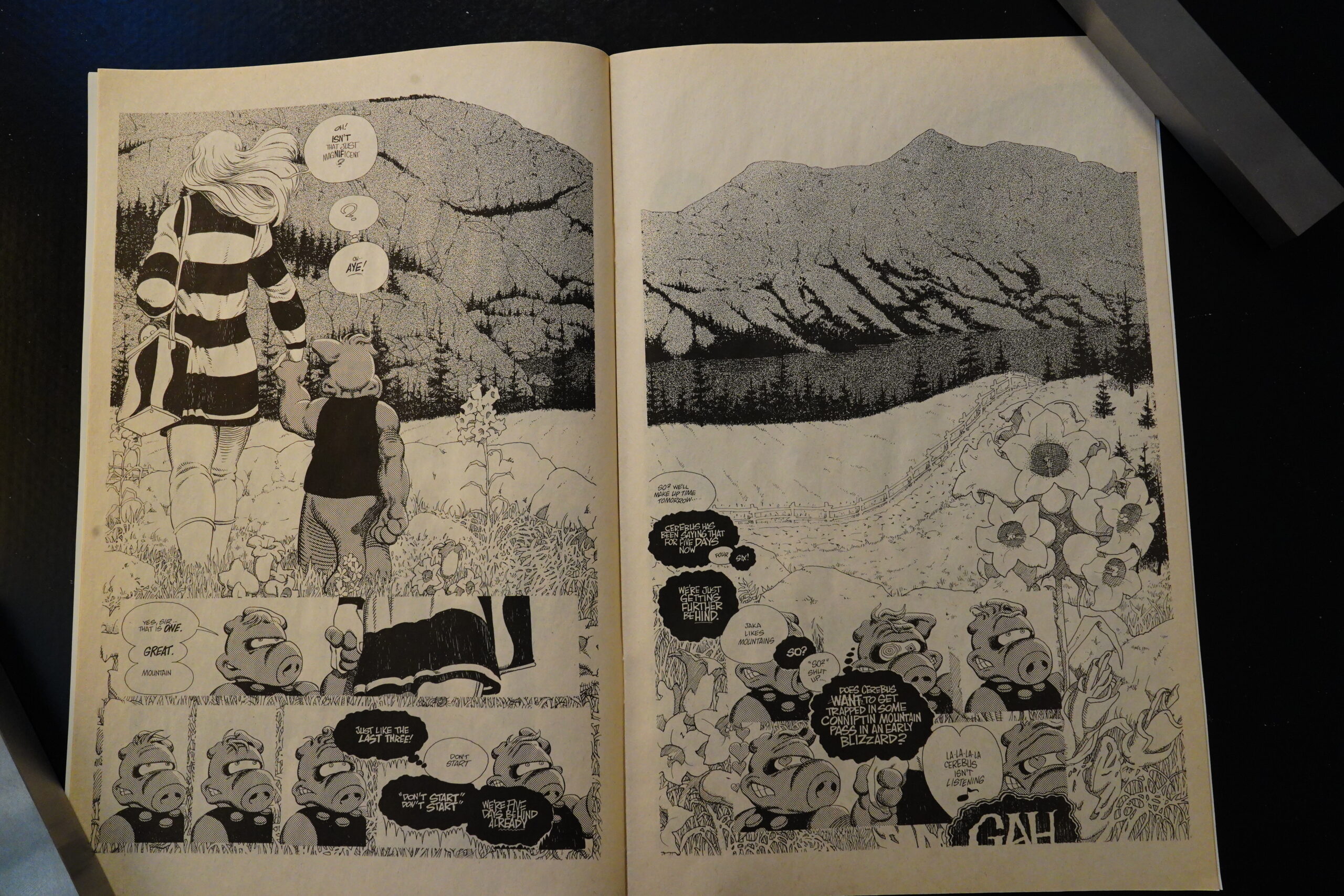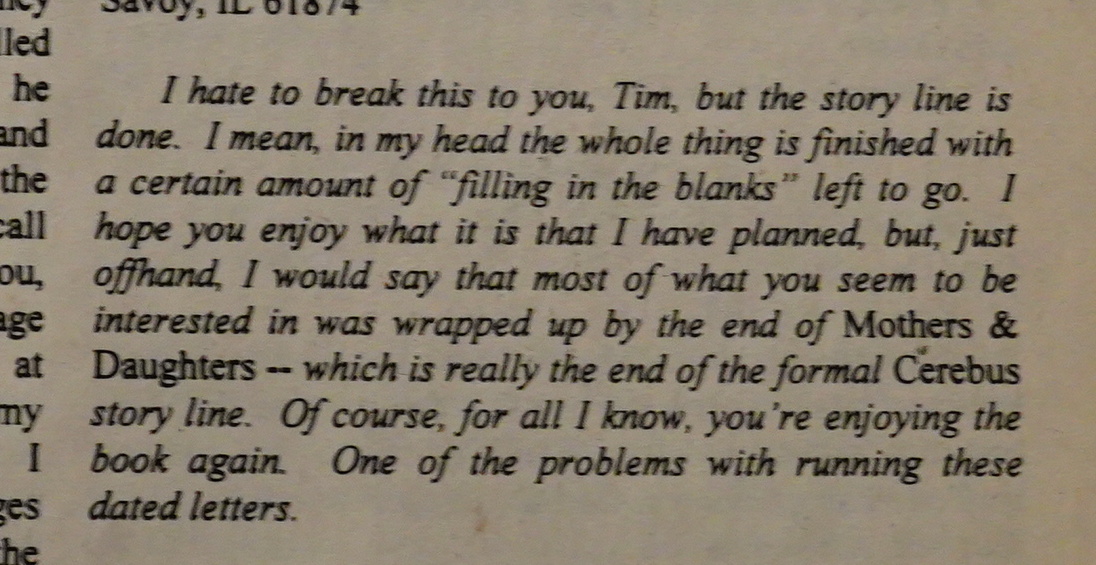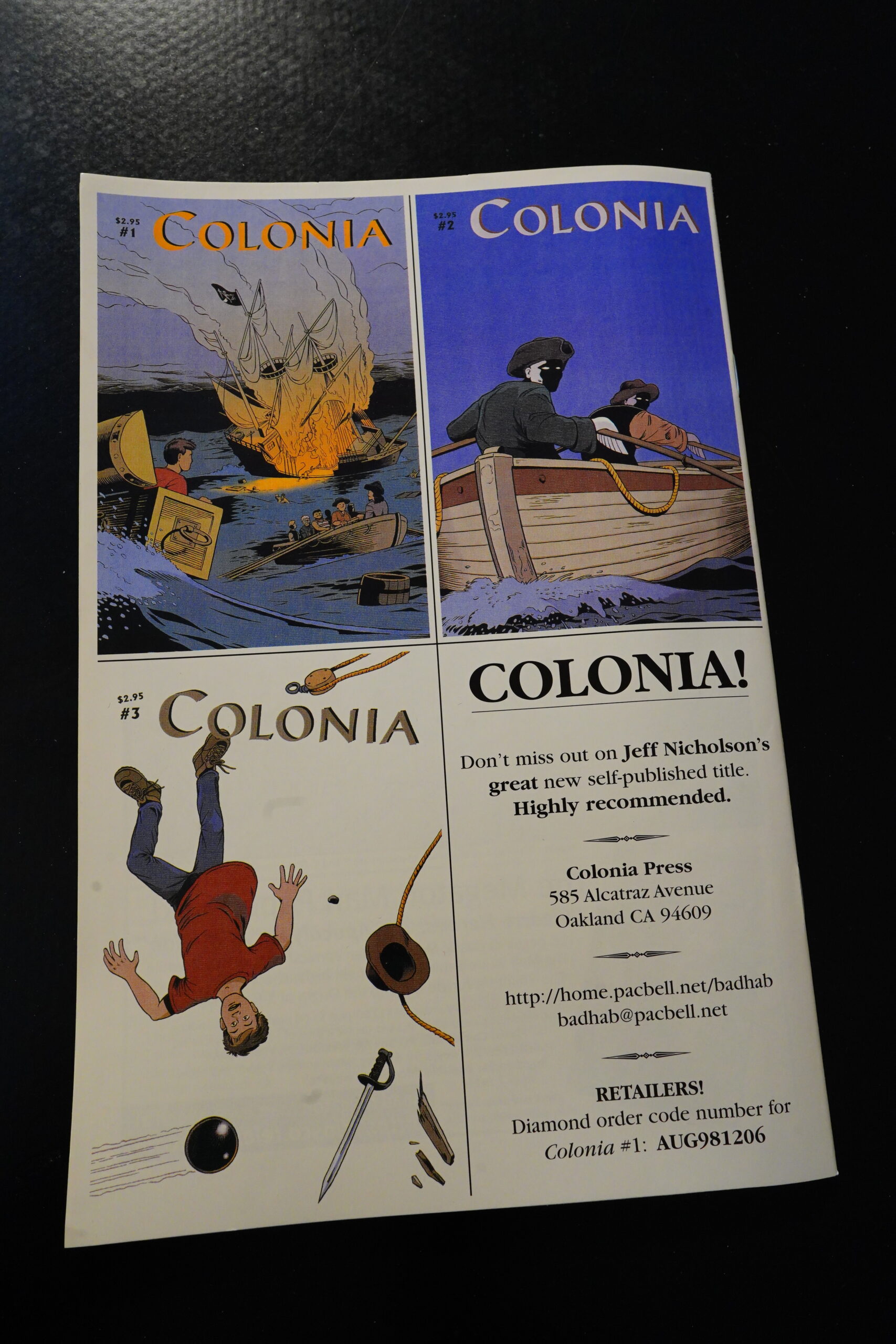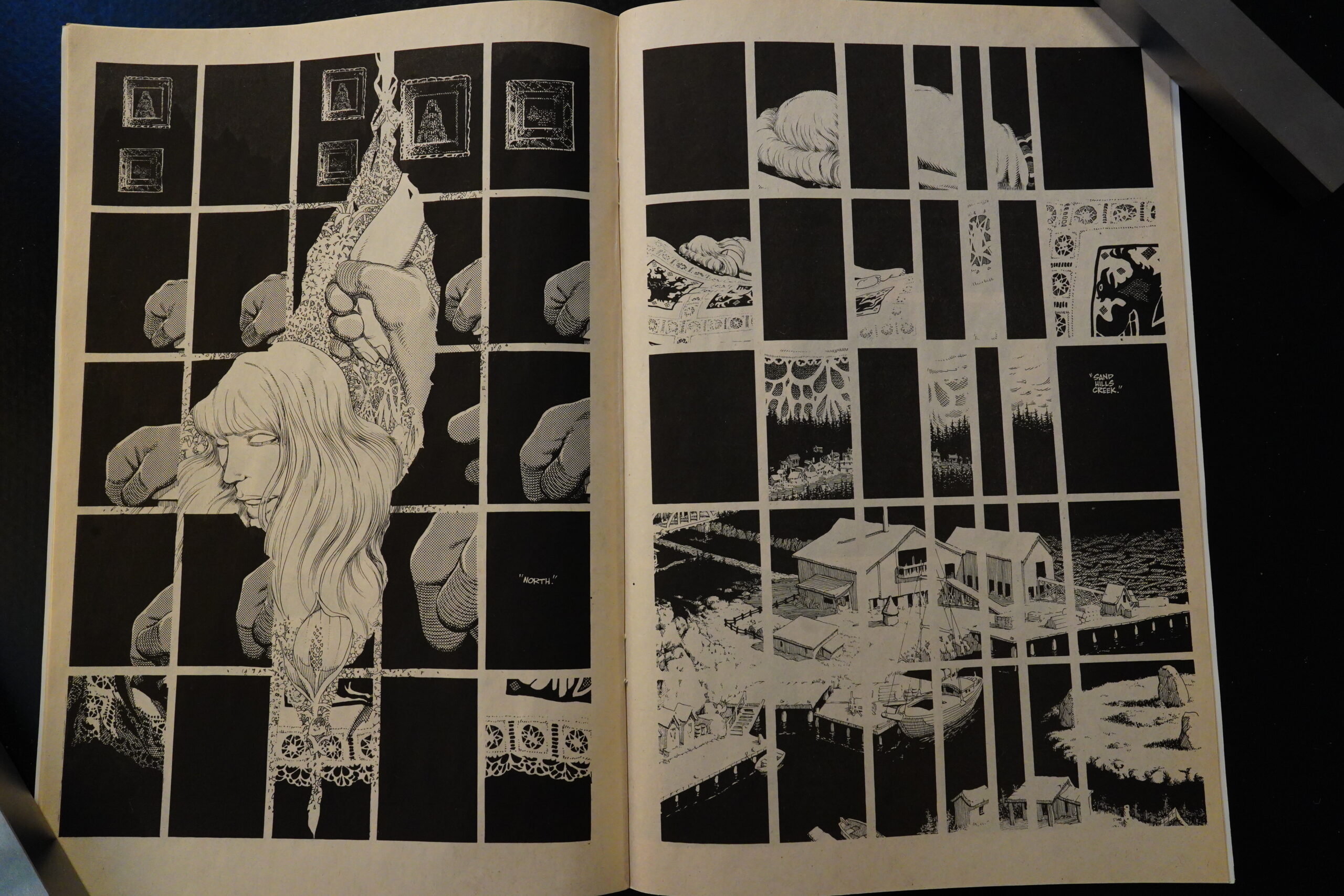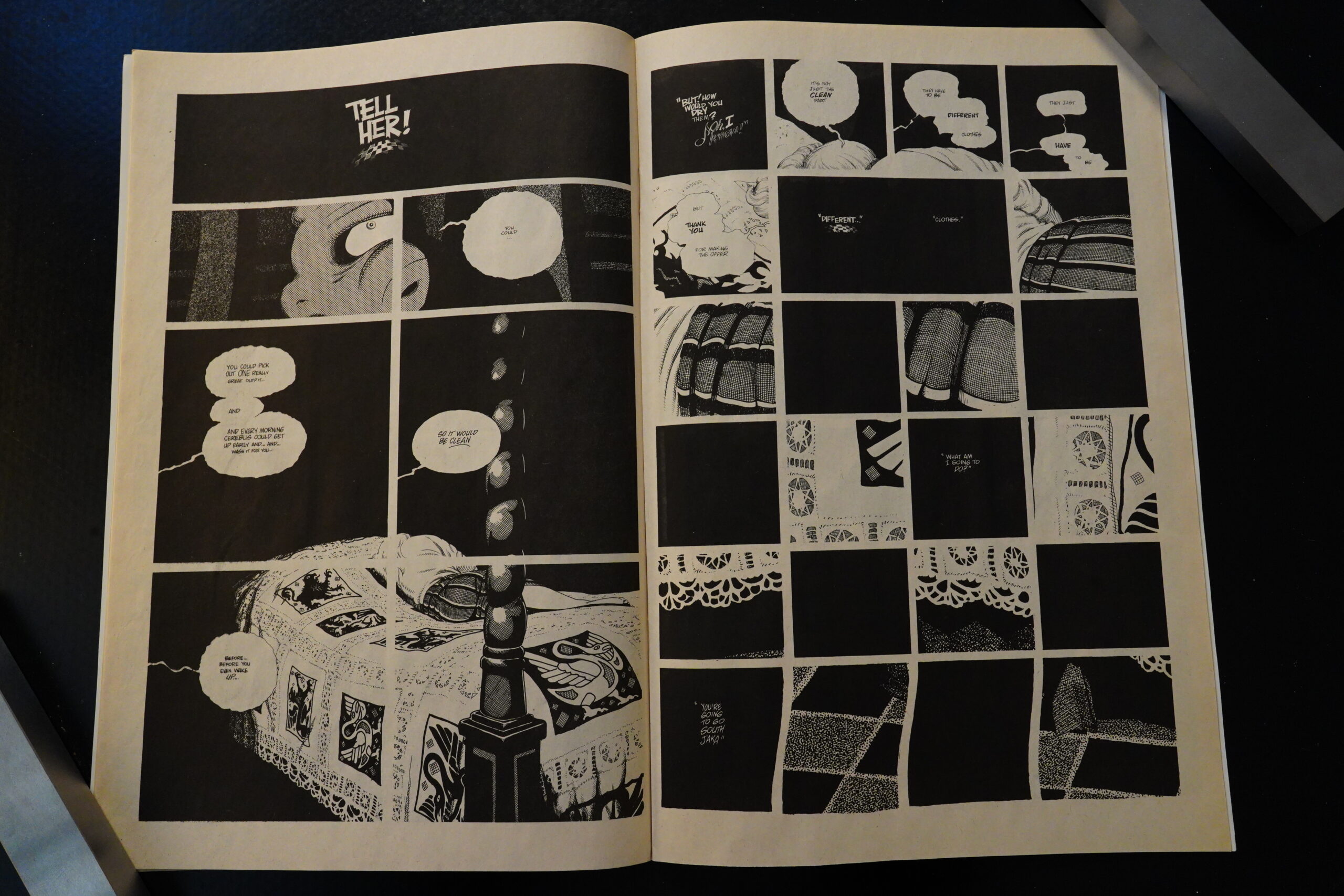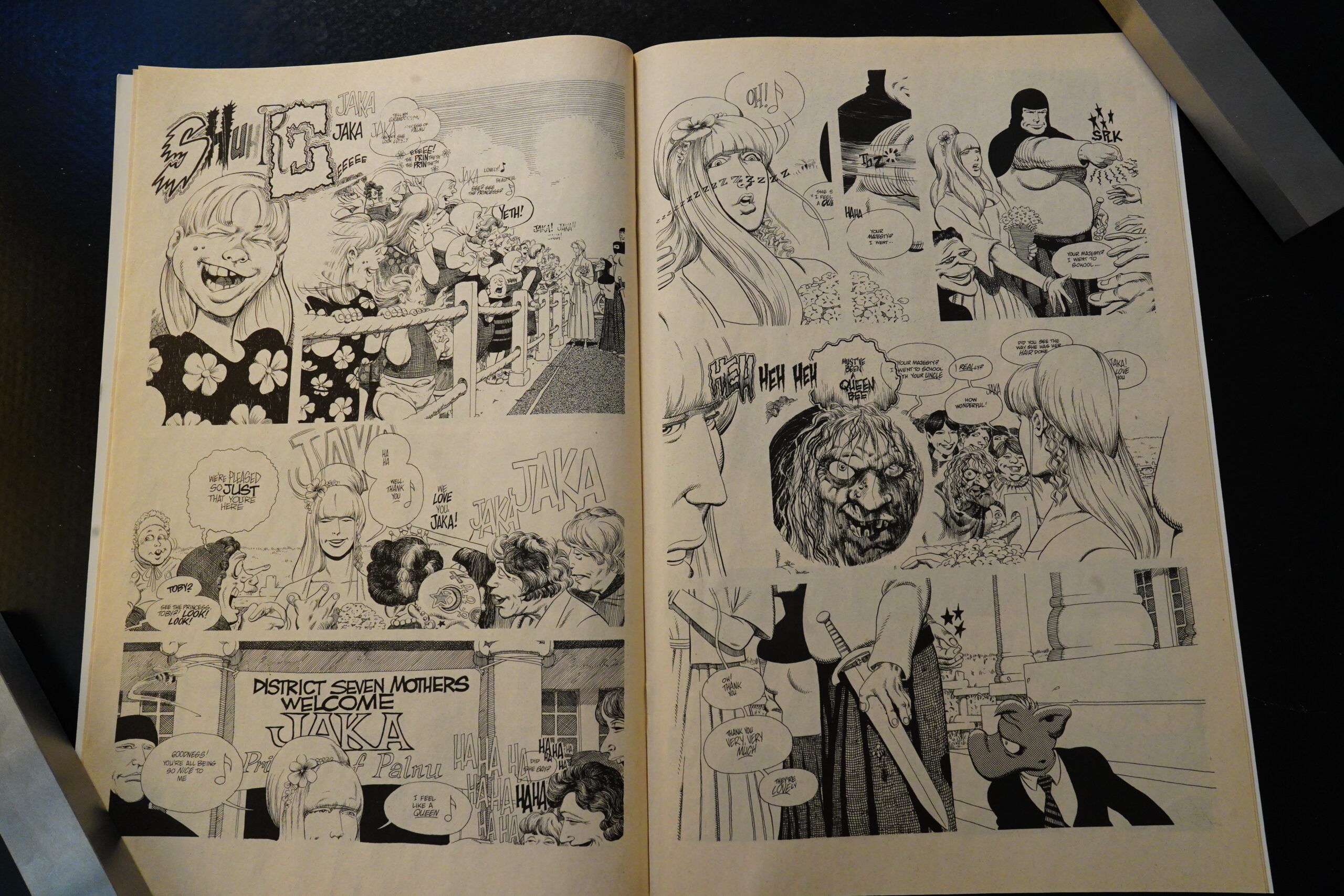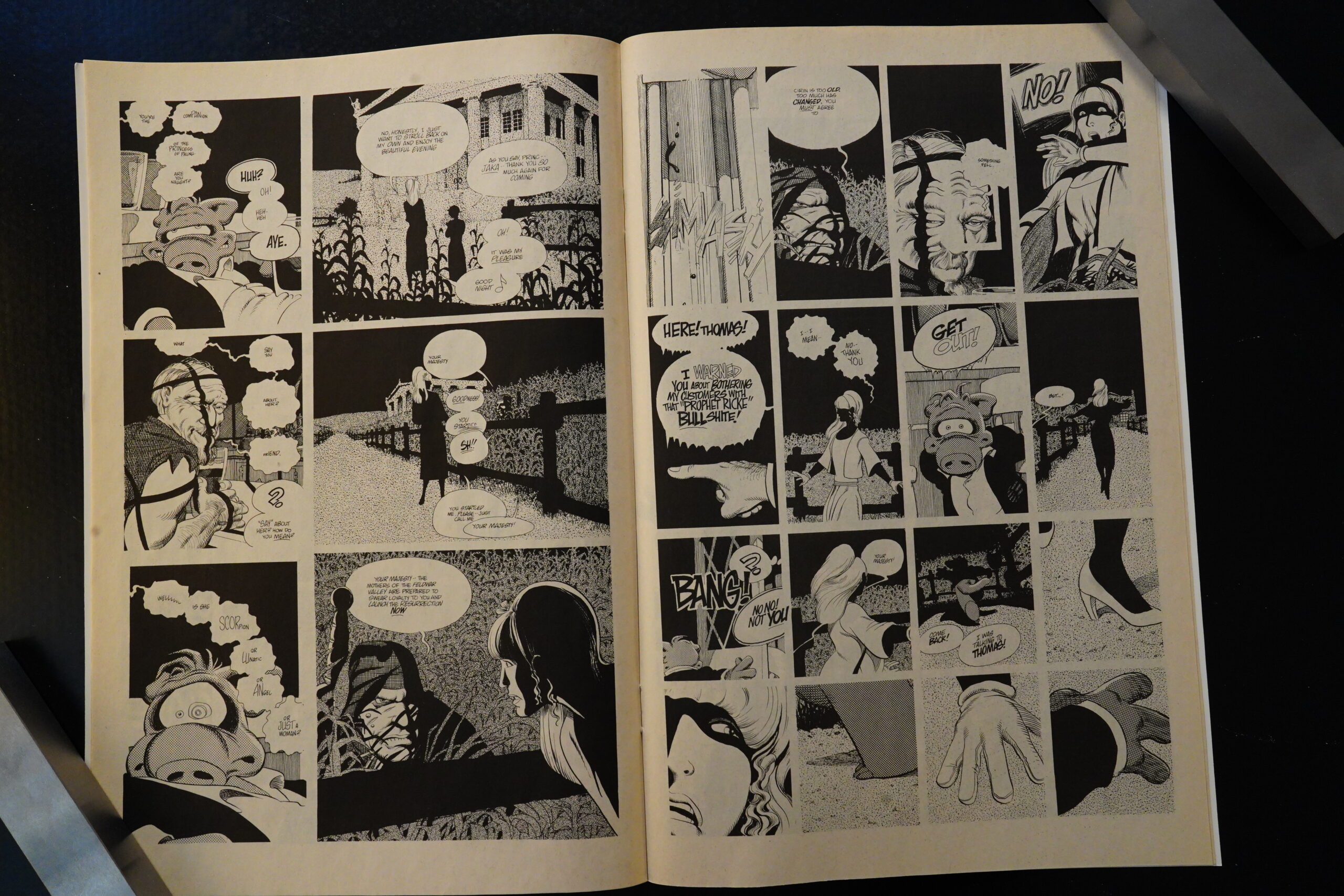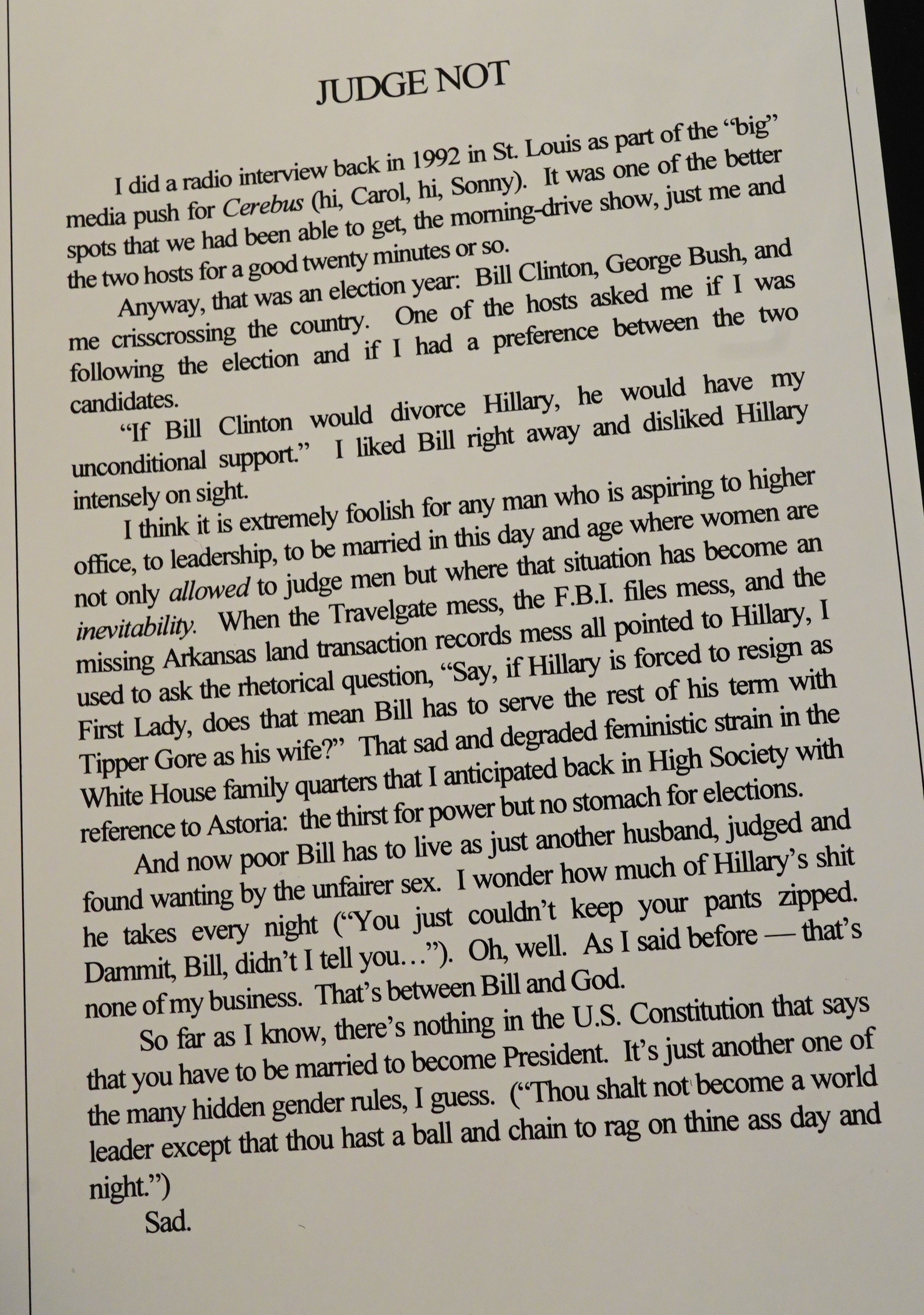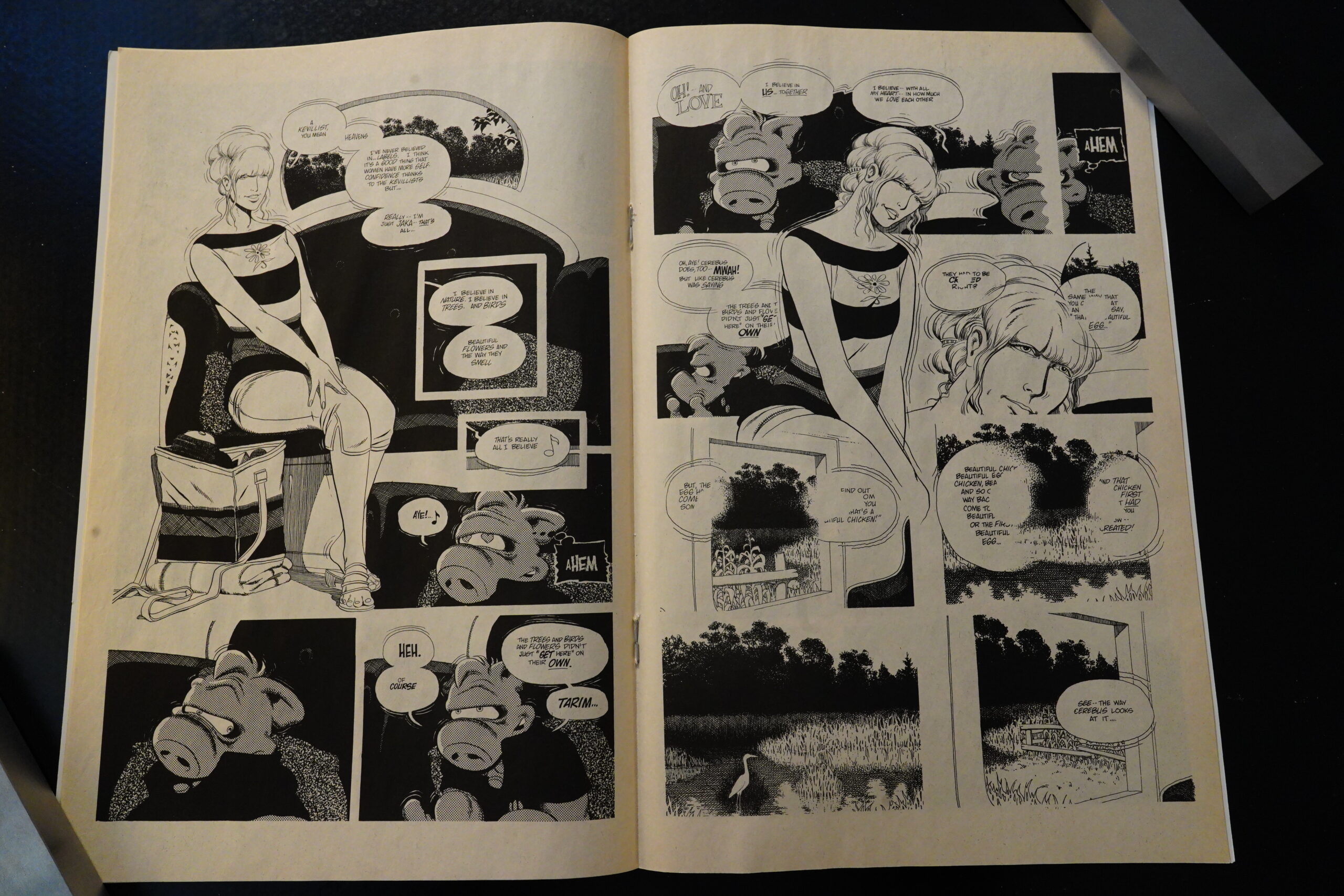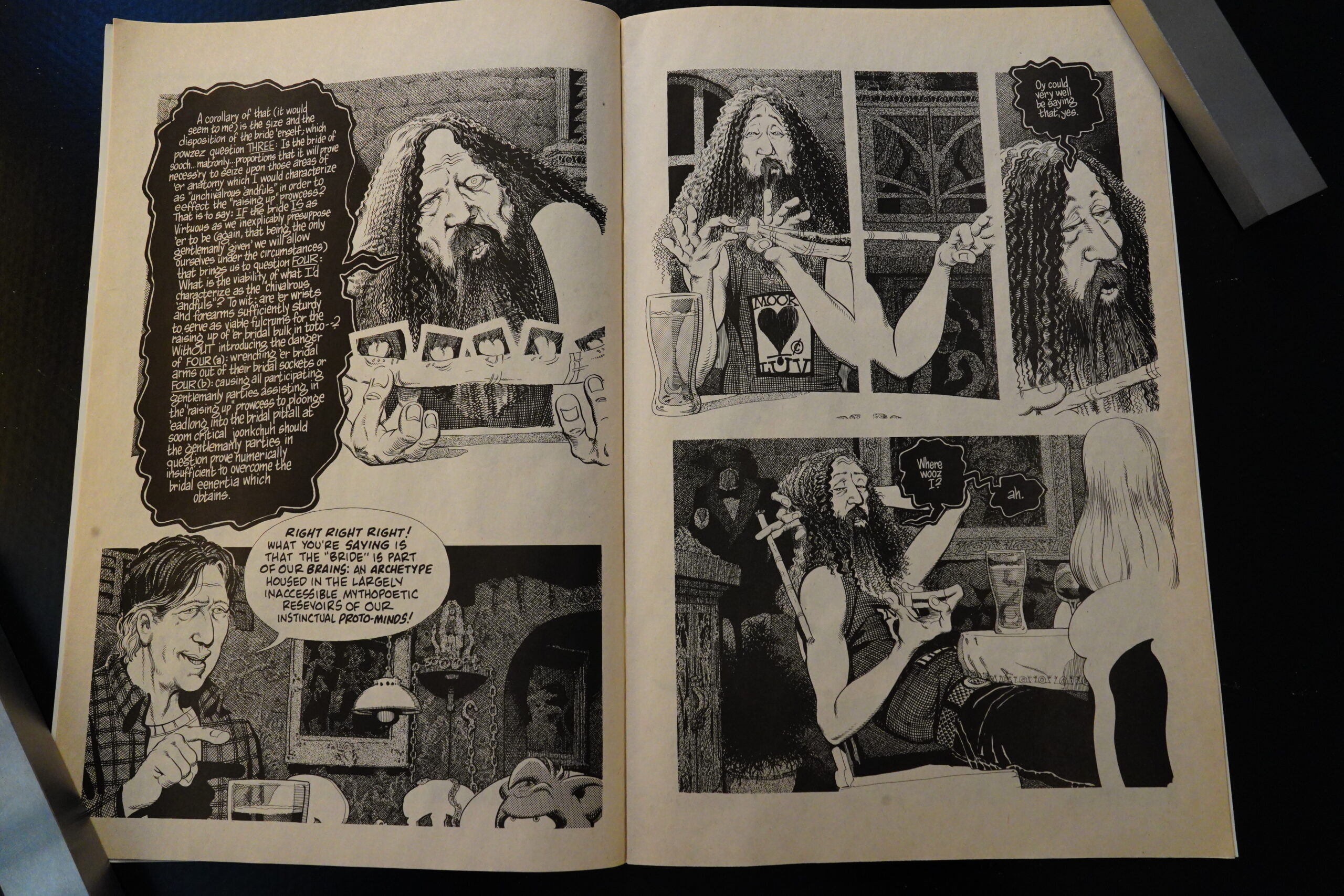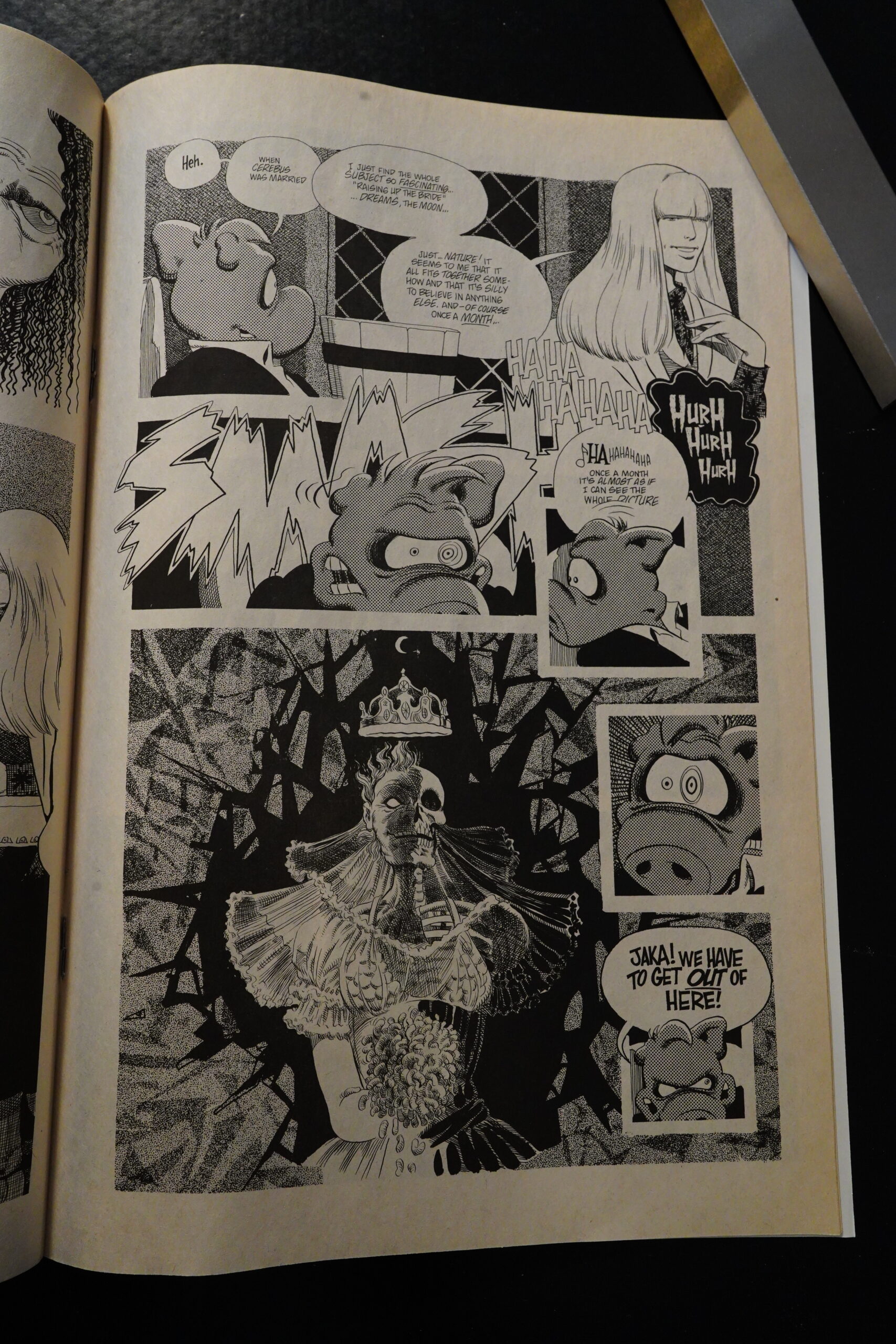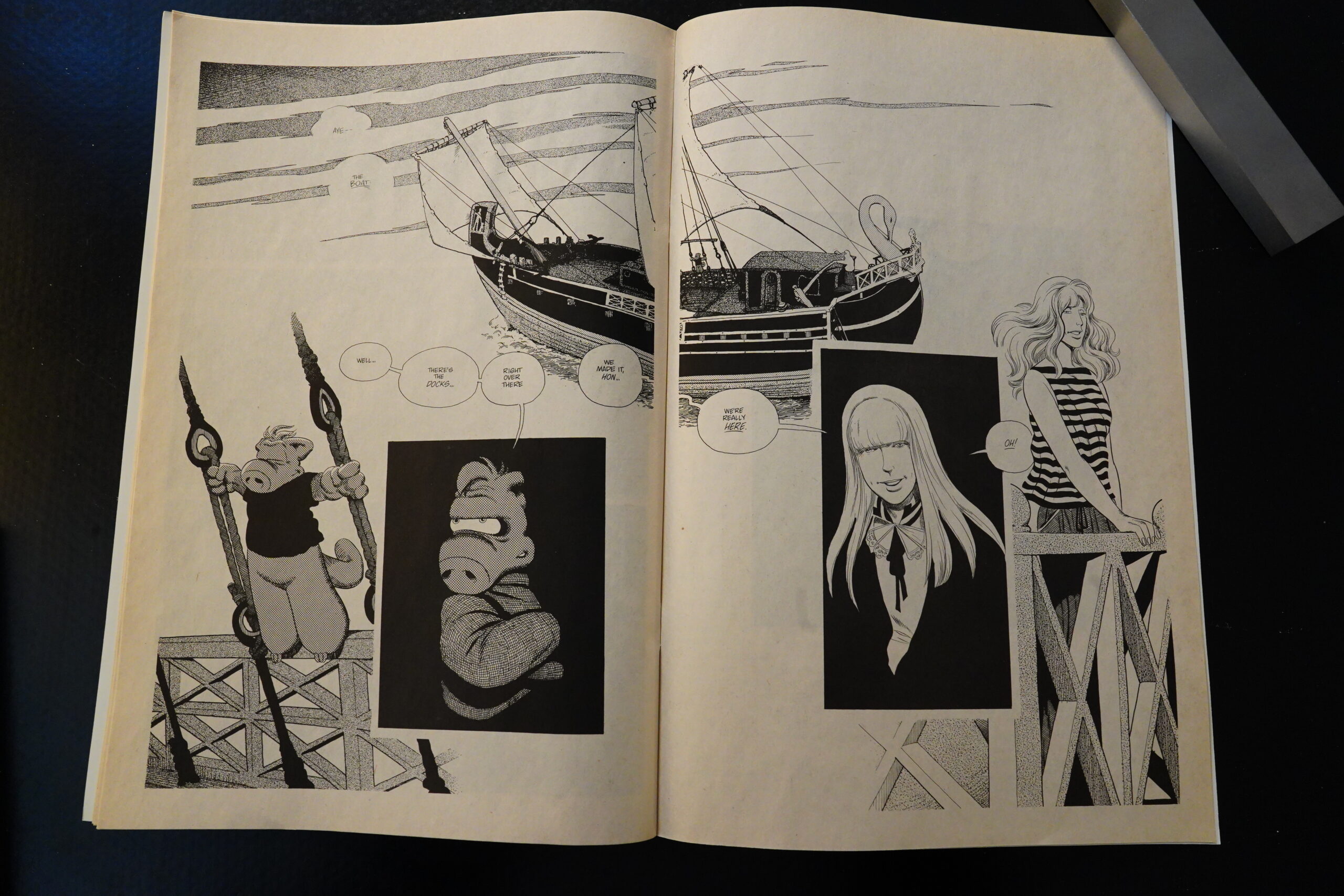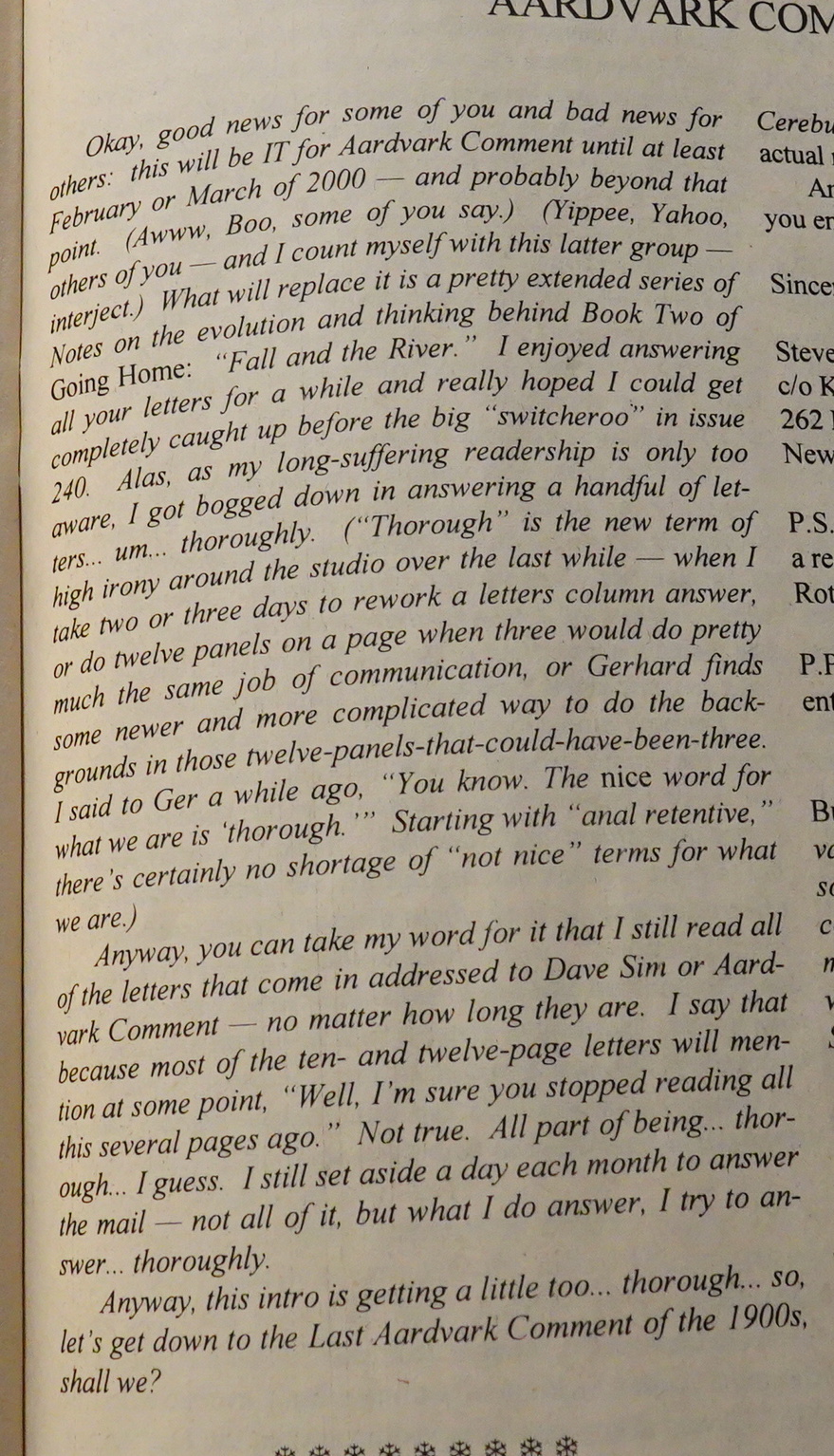Cerebus (1998) #232-239 by Dave Sim & Gerhard
What’s this then? Only eight issues covered in this blog post? Isn’t Going Home a longer epic?
Yes, indeed, as you can see from the inside front cover down here. But the first eight issues are the first book, “Sudden Moves”. And! When doing the collections, the first two books were published under the name Going Home, and the third book, “Form & Void”, was published under the name, er, Form & Void.
Confused yet?
As we recall from the last blog post — Rick’s Story ended with Cerebus and Jaka meeting up (randomly) and they decided to go off together, totally in love with each other. And I’m actually kinda excited about re-reading these comics, because I have no recollection whatsoever about what happens in these issues. (I do recall Form & Void being a Hemingway parody, and the second book is perhaps the F. Stop Fitzgerald parody?
(Also note that Sim has stopped doing artwork for the covers, and is instead running indifferent landscape photos. Less work, eh?)
OK, let’s read “Sudden Moves”, and let’s all just be thankful that this is going to be a shorter blog post than normally. But on the other hand, there’s gonna be more Cerebus blog posts than I had anticipated, so it’s all eh
“… I spiked one back that drilled a hole in her metaphorical paddle” “Ding. Round One for me” Christ what an asshole.
Cerebus had been featuring various comics people for quite a while now, but Greg Hyland? That’s kinda obscure. And it’s a pretty nasty caricature. I mean, I assume it is; I’m not quite sure who he is… Let’s see… Oh, he did Lethargic Lad? Well, OK.
So — Jaka and Cerebus are travelling in Cirinist country — but apparently the Cirinists are really ensuring her passage in a kind of obsessive manner.
Wow, that’s a happy-looking Cerebus. Also a bit deranged-looking? Sim’s graphical depiction of both Cerebus and Jaka throughout this book is very engrossing.
Drama! Kevin Eastman said (in the Comics Journal) that Sim put his foot down on further reprints of the eight Teenage Ninja Mutant Turtles issue (which features Cerebus).
(Also note “my preliminary scan for Comics Journal ‘Dave Sim slams’. Sort of a hobby with me.” Heh heh.)
Sim explains that it has more to do with getting a work-for-hire contract from Eastman’s people, and that he’s worried about firms reprinting the issue and then claiming the Cerebus trademark for themselves. Now, I’m not a lawyer, but that just seems pretty weird? I mean, I guess they could, and if it ends up in the courts — Marvel vs. Dave Sim — that’d be a drag… OK, perhaps Sim has a point.
Meanwhile, 20 years later, Sim reprinted the issue himself (in collaboration with Waverly Press). And there are… *counts on fingers* *counts on toes* *gives up and guesstimates instead* 34 different cover variations? And a bunch of other effluvia and more etc etc.
Not that there’s anything wrong with that, but it’s nice that Eastman allowed that to happen, eh?
Sim starts including maps showing their travels, and I really like that — one thing that vexed me as a teenager was that I didn’t really have a feeling for the geography of Estarcion. I know, there was a map in early Cerebus issues, but I was too late to the party to see that, so I always felt at a loss when different invasions/etc were being discussed.
Probably not Lord Julius — probably one of his doubles, but that’s what Lord Julius would want us to think, eh?
I have to agree with Cerebus — that’s not a particularly beautiful mountain.
“The story line is done.” “Mothers & Daughters […] is really the end of the formal Cerebus story line.” So Sim wasn’t quite lying back in issue er 182? when he said that Cerebus was ending with issue #200.
I’ve been pondering (since yesterday!) doing a blog series about self publishers — that movement in the 90s was quite fascinating, and I think now mostly forgotten (except for Bone and… Bone). It might make for an entertaining (re-)read — starting about (say) 1991 and going up until the new millennium… We’ll see.
After being stuck in the tavern for 30 issues, this must have been a relief to draw. That is, the graphics become more playful again, and more interesting.
Oh yeah, the storyline — up until now, Jaka has seemed like a pretty smart cookie, carrying most of the dialogue and saying interesting stuff. The major crisis here is that (on their way back to Cerebus’ hometown), there are no more clothes stores, and Jaka just can’t stand wearing the same outfit two days in a row. She has a complete breakdown over that.
It just seems… you know… like total bullshit? I mean, character building wise? This was the best Sim was able to come up with?
On the other hand, my guess is that Sim meant to paint her as a complete ditz throughout this story, but it doesn’t really come off that way. I’ve talked before about the disconnect between Sim means to convey and how people read his work… The entire thing could be Sim going “see!? you morons! Jaka was never worth even thinking about! she’s a woman for God’s (may the peace and blessings of Allah be upon him) sake!”
One thing I have to say in Sim’s defence, though, is that he’s really good at actually depicting them together in a way that allows us to understand why they’d want to be together. I’m reading The Talented Mr. Ripley at the moment (only up to page 100 — NO SPOILERS), and Highsmith definitely isn’t good at this sort of stuff. Tom Ripley is able to charm his way into their lives, but Highsmith doesn’t give us even an inkling of why they’d want him in their lives: It’s stated that he’s charming, but he’s never shown to say anything even vaguely funny, or interesting, or well anything — so we have to take it on faith that when he’s not on the page, he’s just charming as all out. It’s like when an author writes “and then he told a joke that made everybody laugh” (I’ve seen sentences just like that in books), you know that the author wasn’t able to come up with an actual joke…
ANYWAYS. Sim’s better than that. Much better.
I think “Sudden Moves” is the best thing Sim has done since Church & State, really. It’s witty, but it’s filled with dread: Both Cerebus’ constant worry about losing Jaka, but also these little weird things that happen that we’re not quite sure have a meaning or not.
It’s tense, it’s a bit bewildering, and it is (dare I say it) exciting. This probably means that the next book is going to defuse everything and have it all mean nothing, so I’m keeping my enthusiasm curbed a bit.
Hey! Now I know who Trump reminds me of!
Sad.
Sim’s storytelling here really is gripping — they way the speech balloons start becoming annihilated when Jaka really can’t talk about this any more.
And then randomly, Alan Moore and Rick Veitch show up — and I’m not sure they actually bring anything to the storyline, but what the hey.
The dread. And what does it all mean! (Since this is Cerebus, probably not a lot.)
And then the book ends on an up note, I guess, but a qualified one.
It’s good! It’s actually good. So now I’m dreading the next book, because I just can’t believe that Sim kept it up.
Sim announces that he’s going to stop printing letters again for the duration of the next book, because he has so much to info to spew onto the readers (I’m paraphrasing) and he can’t afford to bump the size of the book back up to 32 pages (I’m guessing).
David Groenewegen writes in The Comics Journal #223, page 37:
When I read this story over 18 months as a part of Cerebus, I found it to
be, well, a bit dull. Fascinating in parts, but I did think more than once
“Jeez, Dave, why can’t we have a few issues where something actually hap-
pens?” In the past, the collected Cerebus phone books have been more
readable than the monthly issues, but I was convinced that Going Home
was not going to cut it.
After three years Of stories set in and
around the same pub, I was hoping that we
would see a return to the free-wheeling, fast-
paced Cerebus Of the past, where Dave Sim was
dealing with a thou-
sand things at once,
taking on the whole
world. Instead we got
a six-month walking
featuring
tour,
domestic arguments,
followed by a lengthy
boat trip, featuring
domestic arguments.
Great.
So my first read-
ing of Going Home, as
a monthly serial, was
a letdown. Having
finally freed himself
from the pub where
he had spent the pre-
Vious three years, talk-
ing to caricatures of
Dave Sim’s friends
and acquaintances,
Cerebus then spends “Sudden Moves” (the first
part of Going Home) traveling to other pubs
which are also run by caricatures of some of
Sim’s friends and acquaintances. Cenbus has
been criticized in the past for including too
many specific satires of various comic book
characters (largely manifested in the person of
the Roach), the argument being that this
deters the casual reader. I would argue that any
casual reader of the comic Who was not familiar
with the specific characters would still get the
general point: superheroes and their motiva-
tions generally make little or no sense.
However, Sim’s fondness for lampooning
his friends in print (a trend which has become
much more pronounced since the Roach was
sent on his “ray) seems to be a far more trou-
bling aspect of the book. partly, it is distracting
in the way that the procession of celebrity
cameos in The Player was distracting — you
spend more time worrying about “missing” a
celebrity (or in this case, a creator) than paying
attention to the plot. It almost becomes a test
Of the readeös indie credentials. While it’s a
cute game (and satisfying when you know the
answer), you have to question what it adds to
the work.
More worrying is the sense of insularity it
evokes. The early Cerebus books (High Society,
Church & State) dealt with “big” issues: politics,
sex, religion. Now Sim seems more concerned
With peering only at
his own little corner
of the world, just as
he seems to have
totally
withdrawn
from trying to sell his
book
anymore.
Increasingly Cerebus
seemed to be about
the process of creat-
ing Cerebus, in much
the same way as ’70s
rock stars wrote a lot
Of songs about how
tough life was when
you were a rock star.
Equally, I was
annoyed by what
seemed to be Sim
repeating himself.[…]
The fact is, Going Home reads much better
as a continuous story than 18 individual issues.
In fact, it reads as a damn good Story.[…]
Does this mean that #186 was a colossal
joke, or a cunning ploy to balance out the
Judge’s explanation of the universe in Church
& State? Or is Sim just setting us up for some
grand denouement in which the relationship
between Jaka and Cerebus results in Cerebus’
destruction, thus “proving” #186? Personally, I
don’t know. Which is one of the reasons I like
Cmebus, and will keep on reading it to the end.
Sim keeps throwing in enough to keep you
guessing, and while I’m hardly champing at the
bit to read another one of his literary parodies
in Going Home II (Ernest Hemingway this time),
I’m smart enough to wait until the end of it,
and of Carebus as a whole, before I judge it.
Tim Kreider writes in The Comics Journal #301, page 354:
This wildly
inconsistent quality is in evidence even within single volumes: Going Home is
composed oftwo distinct halves, one ofwhich is an account ofCerebus and
Jaka’s relationship deteriorating as Jaka sulks in bed, shops compulsively,
and retards their progress, careless of the dangers encroaching on them
Just Like a Woman — but the other, Time and the River (an F. Scott Fitzgerald
pastiche), is as good as anything Sim ever wrote. When I lent it to a friend I
advised her to skip the first half and start with Part II.
!!!
OK, I can’t find any more reviews specifically about “Sudden Moves”, so I think I’ll hold off quoting reviews until I’ve re-read the second book (i.e., tomorrow).
*phew*
This blog post is part of the Renegades and Aardvarks series.

